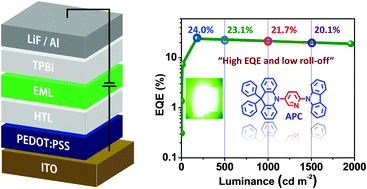An excellent bipolar host material exhibiting EQE of 24.0% with small efficiency roll-off in solution-processable thermally activated delayed fluorescence OLEDs†
Abstract
Highly soluble functional materials acting as hosts for thermally activated delayed-fluorescence (TADF) emitters are urgently needed to stimulate the development of cost-effective, solution-processable, high-performance organic light-emitting diodes (OLEDs). An organic material, 10-(6-(9H-carbazol-9-yl)pyridin-3-yl)-9,9-diphenyl-9,10-dihydroacridine (APC), was designed and facilely synthesized by integrating electron-donating diphenyl acridine and carbazoles at the 2- and 5-positions of electron-accepting pyridine (D–A–D′ type architecture). The high triplet energy (2.82 eV), thermal robustness (thermal decomposition beyond 350 °C), appropriate highest occupied molecular orbital and lowest unoccupied molecular orbital energy levels, balanced charge-carrier transport ability, and good solubility of APC supported its designation as a host material for solution-processable TADF-OLEDs. Two different types of TADF OLEDs were fabricated by varying the hole transport material (HTM) while consistently using APC as the host and familiar t4CzIPN as the green TADF emitter, and their device characteristics were compared. At first, the devices fabricated using PVK as HTM (ITO/PEDOT:PSS/PVK/EML/TPBi/LiF/Al) that could use an orthogonal solvent system displayed a state-of-the-art performance with external quantum efficiency (EQE)/current efficiency (CE)/power efficiency (PE) as high as 24.0%/82.2 cd A−1/46.9 lm W−1, respectively. In particular, over 90.0% of EQE was retained (EQE of 21.7%) at the practical luminance of 1000 cd m−2, which is advantageous for display technology. Another class of devices was fabricated by replacing PVK with our recently reported thermally cross-linkable X-TPACz as the HTM, realizing a very low turn-on voltage (2.9 V) and excellent PE of 70.1 lm W−1 (with a similar EQE of 22.8%), which could be very effective for lighting equipment. These excellent outcomes demonstrate the potential of APC as a host material for future solution-processable display and lighting technologies.



 Please wait while we load your content...
Please wait while we load your content...